I’m guest blogging over on my friend Michele Stegman‘s blog today. Although written specifically for NaNoWriMo, this tip really works for any big task. Please stop by and say hi!



I’m guest blogging over on my friend Michele Stegman‘s blog today. Although written specifically for NaNoWriMo, this tip really works for any big task. Please stop by and say hi!

According to popular American folklore, the Pilgrims and Indians celebrated the first Thanksgiving in 1621 with a feast of turkey, potatoes, corn, bread, cranberries, pies, and more.
The stories are wrong – or at least, debatable – on many counts.
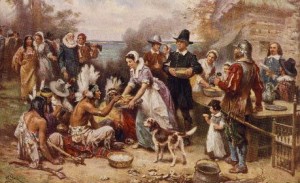 The pilgrims celebrated the first Thanksgiving in 1621
The pilgrims celebrated the first Thanksgiving in 1621
Status: Debatable.
First off, the settlers who arrived in Plymouth in 1621 called themselves “saints” or “separatists.” Their goal in coming to the new world was, like the Puritans’, religious freedom. The term “pilgrim” wasn’t applied to these settlers until the American Revolution. Regardless of what they were called, they may not have celebrated the first Thanksgiving, either. Aside from the fact that harvest celebrations have been held by cultures around the world since before recorded history, there are others who claim the distinction of the first feast actually called Thanksgiving. One of these is Berkeley Plantation on the James River in Virginia, where the Margaret brought 38 English settlers in 1619, who then celebrated with a “day of Thanksgiving.”
Another possibility for the first American Thanksgiving is the town of San Elizario, Texas, where Spanish explorer Juan de Onate led hundreds of settlers after a grueling trek across the Mexican desert in 1598. Upon arrival, De Onate hosted a large Thanksgiving celebration. Others go back even further, and credit another Spaniard, Francisco Vásquez de Coronado, as the instigator of the first Thanksgiving in the same region of Texas while searching for gold.

This guy had a lot more to worry about on the first Thanksgiving than the turkeys did
Turkey was the main dish for this early Thanksgiving feast.
Status: false.
Although wild turkey certainly could have been on the menu, it’s never mentioned in any of the accounts from that time. Original sources mention that the Wampanoag Indians brought five deer, and that the colonists shot wild fowl – though what kind of fowl was not specified. Furthermore, in England deer were mostly found on private estates, and hunting them was a pastime of the wealthy; poaching them was a serious crime. Therefore venison on the menu was a novelty, and was likely the centerpiece of the feast.
Other dishes served at the first Thanksgiving included potatoes, corn, bread, cranberries, and pumpkin pie.
Status: false.
While it’s likely that corn, being one of the native peoples’ staple foods, was consumed at this early harvest celebration, it’s probably the only thing on the above list that was. Potatoes weren’t yet a common part of the English diet. Cranberries are bitter without sugar, which was expensive and considered a delicacy at the time – if the settlers had any with them, it likely wasn’t much. They also didn’t have wheat flour, needed for breads and pie crusts. However, they probably did eat pumpkin – boiled, most likely.
Turkey makes us sleepy.
Status: false.
While turkey does indeed contain tryptophan, which in pure form can induce drowsiness, for the stuff to really work one needs an empty stomach. As part of a big Thanksgiving meal, there’s too much else going on in the body for the brain to absorb enough tryptophan to get sleepy. Sure, the food coma definitely happens, but the more likely causes are the fact that we’re finally relaxing after a busy week, drinking alcohol, or the sheer amount of calories in that dinner we’ve just consumed.
Black Friday is the busiest shopping day of the year.
Status: debatable.
Despite the hype and attention given to shopping on the day after Thanksgiving, some sources say that the Saturday before Christmas is actually the busiest. Others point out that while the Saturday before Christmas used to be the busiest, it is now, in fact the day after Thanksgiving. All I know is that I avoid going out on both days (thank you, Amazon!).
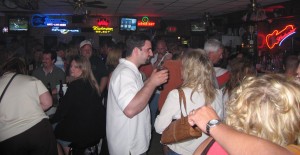
A busy night at the bar in 2006
The night before Thanksgiving is the busiest bar night of the year.
Status: true.
Although the evidence is mostly anecdotal, the Wednesday before Thanksgiving is, in fact, the busiest night at many bars. Also called Black Wednesday, it’s a time when college students are home for the holiday, and want to party with friends before being stuck with family for all the following day. For others, it’s an extra day in the middle of the week to go out and get wasted without having to go to work the next day. It’s been theorized that people also go out to bars because they’ve spent the day cleaning and getting prepared to host Thanksgiving the following day – so who wants to have people over and mess everything up? When we owned a bar, my husband always got ready for work that night like he was going into battle. Some years that was a good comparison!
Got any other Thanksgiving myths or fun facts to share? Do you go shopping on the day after Thanksgiving, or to the bar the night before? And regardless of your beliefs, if you’re celebrating Thanksgiving today, here’s hoping it’s a good one!
The first Thanksgiving 1621 by J.L.G. Ferris, via the Library of Congress, public domain.
White-tailed deer photo via Wikipedia, creative commons license.
Bar photo ©2006 by me.

EDITED Monday, October 22, 2012: This blog post is now nearly a year old. I have nothing to do with this event; this post is just an informational article sharing about something cool that happens in Dayton. If you want to volunteer for the Feast, or otherwise want more information, do not email me – I don’t have the answers you’re looking for. I’m guessing you found this blog post through a Google search, so I suggest you try some of the other links that you found while searching. Thank you!
Sometimes, things happen in Dayton that restore our faith in the human race.
One of those is the Feast of Giving.
Now in its third year, the Feast of Giving is a full-blown Thanksgiving dinner – turkey with all the trimmings – held at the Dayton Convention Center, for FREE. Although some people emphasize those who have financial need, or those who have no one to spend the holiday with, all are welcome. The event’s sponsors stress that they want “people from all walks of life to attend.” The primary sponsors are area businesses, including ABC 22 & Fox 45 Dayton’s News Source, Dermatologists of Southwest Ohio and Lastar Inc., manufacturer of low-voltage cabling and the parent company of Cables to Go.
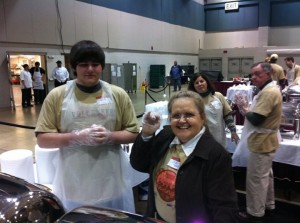
Volunteers at last year’s Feast of Giving
Donations are accepted from others as well; click on the Dayton’s News Source link for donation information. Over 3,500 people attend the event each year, and many people volunteer to help. Volunteers are capped at 500, and every year, several times that offer to volunteer. As many as 2,000 would-be volunteers have been turned away in the past, by the Feast and its predecessor.
While the Feast of Giving is only in its third year, it follows a long tradition started in 1969 by Arthur Beerman, founder of Elder-Beerman stores. Mr. Beerman had suffered a heart attack earlier that year. While hospitalized, he received hundreds of get-well cards. After he returned home, he started the dinner “to thank the good Lord for letting me get home for Thanksgiving,” and also to give back to the community that had been so good to him. He died the following year, but his family and the Beerman Foundation continued to host the event every year until 2009. According to the Dayton Daily News, “The annual Thanksgiving dinner was believed to be the largest of its kind in the nation having served an average of 4,000 turkey dinners per year.” In 2009, the Foundation’s board announced that they would not be hosting the Thanksgiving Dinner, as they had determined that its funds would be more effectively spent on charities and programs with a broader scope. That year, the above sponsors combined their funds and efforts to keep the tradition alive with the first Feast of Giving.
The Feast of Giving will be held from 11 – 2, and tickets are not required. The convention center is offering free parking, and Dayton RTA offers free bus service to and from the event.
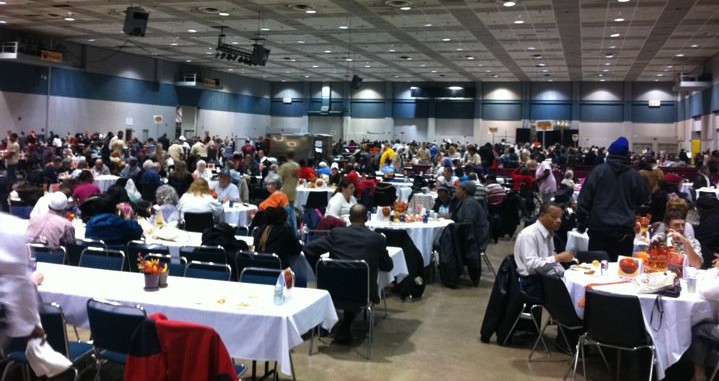
The 2010 Feast of Giving
I’m blessed to have family in the area, and someone has always been able to host (this year, me), so I have never attended the Feast of Giving or the Beerman Thanksgiving Dinner. But it’s cool to think that the biggest event of its kind is right here, every year, for anyone who wants to go. If you live in the area, have you ever attended? If you don’t live around here, does your community offer anything like it?
Photos via the Feast of Giving page on Facebook
More at the My Town Monday blog

 I’ve noticed something with my high-school-age daughter, that she’s done for a long time. When she has a tough assignment, whether it’s homework, or a big chore (like clean up her room), she tends to goof off even more. The homework doesn’t get done, and the room never gets cleaned. She’s a super-smart kid. Homework usually comes easily to her. Keeping her room clean should be easy, but instead of picking up and putting away as she goes, she lets stuff pile up until it becomes overwhelming.
I’ve noticed something with my high-school-age daughter, that she’s done for a long time. When she has a tough assignment, whether it’s homework, or a big chore (like clean up her room), she tends to goof off even more. The homework doesn’t get done, and the room never gets cleaned. She’s a super-smart kid. Homework usually comes easily to her. Keeping her room clean should be easy, but instead of picking up and putting away as she goes, she lets stuff pile up until it becomes overwhelming.
And by that point, she doesn’t want to do it. Because it’s hard!
Revisions continue to go slowly. In trying to figure out why, it’s pretty obvious: I keep running up against big plot holes that don’t have an obvious solution, and instead of just doing something about it, I go do something else, like play computer games.
Because it’s hard!
I do the same thing with a sticky revision as my daughter does with homework or a chore that’s not easy.
So that’s my reason, not excuse, for not meeting my ROW80 goals for Yet. Another. Week. I realize I probably have to just power through this stuff and I tried a couple times this week, but the powering-through doesn’t happen quickly. My muses take their good ol’ time handing me solutions to this type of problem and in the meantime, I go play another round of My Farm Life. Sigh. Or this week, I go work on a website I volunteered to do for a promo group I’m in. Either way, the revisions are not coming along as quickly as I’d like.
Sometimes I ask myself Twenty Questions, or rather, Twenty Answers, to the question, “what could happen here?” I get all the mundane, overused, and just plain stupid ones out of the way, and by the time I’ve come up with twenty things, I’ve usually come up with something good.
Other times, it’s just resistance to making a Big Change that’s going to take a lot of work. That’s where I’m at now, in Chapter 15. What’s funny is I checked my spam queue right before I started this post, and found my first, legitimate, not-spam comment in it, from a fellow Row80-er who was having this very problem! So it’s time to take her advice and just make the big change. It’s not even as big as the one she’s been dealing with.
As for my specific goals, I did get Chapter 13 and 14 revised, and there were plenty of those PITA issues in them as well.
For this week, I want to get 15-17 revised. Ideally, I’d also like to get the type-in done for the book so far, and get it out to the beta readers. I’m hosting Thanksgiving, so that’s a day I won’t get any writing done, but I’m blessed to have all my family nearby (which means no overnight houseguests or travel), and my husband also helps. I also have Wednesday and Friday off work, so that should make up for it.
Do you have any suggestions on tackling a Big, PITA Change? Or for figuring out a show-stopper plot hole? How did you do on your goals this week?

 On Sunday, I got the troublesome scene that needed to be inserted, written. Monday is paperwork day, so no writing then, but that was expected. Today I got a little done on the rewrite on the following scene, but had to stop before I finished it.
On Sunday, I got the troublesome scene that needed to be inserted, written. Monday is paperwork day, so no writing then, but that was expected. Today I got a little done on the rewrite on the following scene, but had to stop before I finished it.
It’s the husband’s TV night, and the only way I get writing done then is with headphones. Only problem is, my headphones are wireless – and they needed to be charged. They can’t be used while charging, so…. no headphones. I could have taken my netbook and gotten the writing done elsewhere; instead, I got caught up on other related activities, including one I’d put off for a long time.
I just uploaded the files for Time’s Enemy to Lightning Source for additional ebook distribution. They distribute to over two dozen outlets, including Kobo and Powell’s. So, more places to buy the book = better. I may not sell anything through those outlets. But who knows, maybe I will. And hey, it’s free, since I use Lightning Source for my print books.
So I may not be where I wanted to be with the writing, but I got other stuff done. Lesson Learned: charge the headphones before the battery runs out.
How are you doing on your goals this week?

Or, Caves, Castles and Camaros, Part Two

Camaros grace the lawn at Mac-o-cheek Castle
For the second leg of last month’s Fall Foliage Cruise, sixteen Camaros (and one Saturn Sky) stopped at Mac-o-cheek Castle in Logan County.
I had no idea this place existed.
To be sure, it’s not a “castle” like we associate with in Europe and the UK. Mac-o-cheek (and its neighbor, Mac-o-chee) are more like large estate homes, more in the vein of Casa Loma in Toronto. Neither of these is as big as Casa Loma, but they are older.

Mac-o-cheek Castle
The two castles were built by brothers Abram and Donn Piatt, in the 1860s-70s. Mac-o-cheek Castle was Abram’s, and is the smaller of the two. It was also completed first, and its ownership has stayed in the family since.
What’s really impressive about Mac-o-cheek Castle is the interior. The walls are covered in beautiful wood paneling from native trees, and trimmed by artful scrollwork. All of the furniture inside was actually used by the Piatt family.
Neither of the Piatt brothers had the intention of opening his home to the public, but people were continually stopping by and asking to see. Unwilling to be rude, the family admitted the tourists. This went on beyond the turn of the century, until weary of the intrusions, the families decided to charge admission, thinking it would discourage would-be visitors. Instead, it had the opposite effect.

Elaborate woodwork graces the interior of Mac-o-cheek Castle
Still offering tours, the Piatt family occupied Mac-o-cheek until 1989, moving first into the back rooms of the house, and later into the servants’ quarters. After that, the tours continued, along with ongoing restoration work.
Mac-o-chee Castle sits a little less than a mile away, and was built by Donn Piatt, the elder of the brothers. Mac-o-chee is the larger and more elaborate of the two homes, but is not as well-preserved. Unlike its neighbor, Mac-o-chee was sold out of the family around the turn of the century. Three owners and six decades later, Piatt descendants regained ownership of the home, but it had suffered a good deal of damage in the interim.

Sixteen Camaros parked outside Mac-o-chee Castle enhance the property's beauty
Like Mac-o-cheek, Mac-o-chee is filled with beautifully-crafted woodwork. It also boasts painted ceilings reminiscent of those found in the great castles of Europe. Sadly, the majority are not in good condition, and due to the sales, the antique furniture inside is also not original to the property.
Both properties are well worth the price of admission, which is $12 per castle, or $20 for both. Children get an additional discount, as do groups of 20 or more with reservations. So if you’re in the area and are looking for a day trip, consider the castles! As for the sixteen Camaros and their occupants, a good time was had by all.
Did you know there was anything like this in Ohio? What about where you live?

 I am late posting today’s ROW80 update because, well, there isn’t much to update. After the early part of the week’s quick success getting Chapter 12 marked up, things slowed down. A lot. In revising Chapter 13, I ran into a bottleneck. One new scene needed to be added, but before I could write it, I needed to firm up the characters’ motivations for doing the (otherwise stupid) things they were doing. That took a while. I also forgot to take into account that yesterday was RWA chapter meeting day, and for me, that’s a good 6-7 hour chunk of time, including the drive to and from which is an hour each way.
I am late posting today’s ROW80 update because, well, there isn’t much to update. After the early part of the week’s quick success getting Chapter 12 marked up, things slowed down. A lot. In revising Chapter 13, I ran into a bottleneck. One new scene needed to be added, but before I could write it, I needed to firm up the characters’ motivations for doing the (otherwise stupid) things they were doing. That took a while. I also forgot to take into account that yesterday was RWA chapter meeting day, and for me, that’s a good 6-7 hour chunk of time, including the drive to and from which is an hour each way.
I got about half of the new scene written yesterday, and finished it up today. I still need to write a new beginning to the following scene, needed due to the prior new scene, and the aforementioned character motivations.
So, less progress than I would have liked. I’m not making excuses, but here are the reasons:
The reason for all this? As I told one reader who didn’t want to wait until December for Time’s Fugitive: “Believe me, you don’t want to read this book now. It’s full of plot holes, confusion, and characters doing stupid things. I’m making it into a book you will want to read.” Hopefully!
For this week, I’d like to get revised through Chapter 15. I’m hesitant to commit to that, as both 14 and 15 are going to require a lot of work. But I’m through the block on 13, and think the rest of it won’t be too bad. So just that and 14 doesn’t seem like quite enough. Also, I don’t have a ton of other stuff going on this week, so… maybe!
Do you find yourself setting goals without taking other commitments and the difficult of the task into account? How does it work out for you?

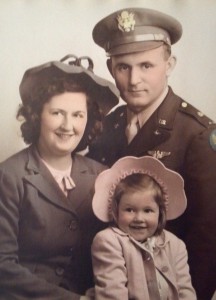
Col. Wilcox with his wife and daughter, following the end of WWII
Tomorrow is Veterans Day in the U.S. Originally called Armistice Day to celebrate victory in WWI, the holiday was declared by President Woodrow Wilson in 1919, in remembrance of those who made the ultimate sacrifice during that war. It was later expanded to include all veterans, including those who served and survived.
I’d like to honor one of the latter, the late Colonel Robert E. Wilcox, my husband’s grandfather. Col. Wilcox was the highly decorated pilot of a B-29 bomber, and served in Army Air Corps during WWII, and later in the U.S. Air Force in the Korean conflict.
He was a two-time POW. The first time, he was held in northern Japan in a concentration camp, and wasn’t released until Japan’s defeat. He’d been presumed dead for nearly a year by then – the military already had a headstone made for him and planned for placement in Arlington Cemetery. It was due to the efforts of the Red Cross that he was rescued at the war’s end, and this was something he never forgot. One of his hands was broken in multiple places, and he also credited the Red Cross for getting him prompt medical attention and for arranging multiple, complex (for the time) surgeries that restored to him the full use of his hand.
Despite his harrowing experience, he went on to serve in Korea a few years later, and again was taken prisoner.
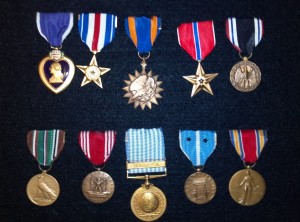 Colonel Wilcox’s accomplishments were many. The medals shown here recognize some of the missions and campaigns he served in during both wars. The Purple Heart was, of course, for the wounds he suffered while a prisoner of war. The medal on the upper right states was “Awarded for Honorable Service while a Prisoner of War, for the United States of America.” He also was recognized for completing 25 missions as a bomber pilot, denoted by the medal in the center on the top row. The lower center medal is for “Service in Defense of the Principles of the Charter of the United Nations” during his service in Korea.
Colonel Wilcox’s accomplishments were many. The medals shown here recognize some of the missions and campaigns he served in during both wars. The Purple Heart was, of course, for the wounds he suffered while a prisoner of war. The medal on the upper right states was “Awarded for Honorable Service while a Prisoner of War, for the United States of America.” He also was recognized for completing 25 missions as a bomber pilot, denoted by the medal in the center on the top row. The lower center medal is for “Service in Defense of the Principles of the Charter of the United Nations” during his service in Korea.
He also was awarded the Bronze Star and Silver Star.
Grandpa never talked about these awards, or his time in the military. Despite his achievements and service, he always seemed to regard it as a duty, simply something one did.
He always kept busy. After he retired from the Air Force after 20 years of service, he went to work as an electrical engineer for NCR, until his retirement from there 25 years later. Throughout his life, Grandpa Wilcox was always committed to serving others, and never forgot what others had done for him. He flew for the Civil Air Patrol during the 70s, and later, volunteered for the Red Cross along with his wife, my husband’s grandma Mary. When I met my husband in the early 90s, they volunteered a couple days a week, taking elderly people who were unable to drive, to doctors’ appointments, the grocery store or other necessary errands. They were also active in their church, and participated in activities to help others. They served in this capacity into their late seventies, until forced to stop by their own health issues.
Grandpa passed away in 2002, at the age of 84, two years after Grandma’s passing. Although I only knew him for the last ten years of his life, I consider that a privilege. It’s because of him and others like him, that we continue to enjoy the freedoms we have today.
I’m also privileged to have several friends, neighbors and coworkers who served, and to all of them I’m grateful.
Who will you thank tomorrow?

 I just finished re-reading another good short story: “The Spelling Error,” by Athena Grayson. Athena is a writer friend of mine, and “The Spelling Error” appeared in an anthology, Words of the Witches, several years ago. It was as good last night as it was then!
I just finished re-reading another good short story: “The Spelling Error,” by Athena Grayson. Athena is a writer friend of mine, and “The Spelling Error” appeared in an anthology, Words of the Witches, several years ago. It was as good last night as it was then!
What I really liked about “The Spelling Error” was how it breaks a stereotype held by many of us regarding people of pagan faiths. Many of us who grew up in conservative Christian homes probably have heard that pagans were “evil,” or at least, woo-woo new-agey types. While there may be some truth the later, the first couldn’t be further from it.
Lucy Dane is the 12-year-old daughter of a single dad – who also happens to practice pagan worship and the occasional bit of magick. So when her best friend blackmails her into casting a love spell for her, Lucy complies, even though her dad has warned her of the dangers of inexperience and magick, and forbidden its use until she’s older. For herself, Lucy wishes for someone to love her just the way she is.
Her dad, Paul, already does, which is why he’s determined to make his small coffee shop a success – or else Lucy will be sent to live with her grandparents. But things aren’t going so well, until business consultant Mira Taggart shows up to help Paul get his business on the right track. Things quickly heat up between them, and it’s up to Lucy to figure out if it’s the spell she miscast… or something more.
Rather than being the stereotypical expectation, Paul, Lucy, and Mira are well-drawn people so realistic it wouldn’t be a surprise to run into them at the grocery store, kids’ sports, or – of course! – at a coffee shop. Their values are the same as those practiced by those of more “mainstream” American faiths: family first, do no harm, and leave things as you found them – or better. Lucy’s point of view is exactly what we’d expect from an almost-thirteen-year-old who only wants to do what’s best for her friend and family, even if it means going behind Dad’s back.
As a side note, I designed the cover for Athena – a fun project, with the Egyptian influence! (Paul’s particular brand of paganism stems from ancient Egyptian deities and faith.)
If you’re looking for an entertaining and engaging way to spend a half hour or so, check out The Spelling Error! It’s available in e-book form from Amazon, Barnes and Noble, and Smashwords.
Read any good short stories lately? Let me know in the comments!

The first time I heard about hauntings at Wright Patterson Air Force Base was several years ago, when I heard that The Atlantic Paranormal Society was coming to film an episode of Ghost Hunters. Supposedly, a couple of office and storage buildings on base are haunted, as well as the Hap Arnold House.
What I learned more recently, is that there’s a much more haunted place on base: the National Museum of the United States Air Force.
It shouldn’t be any surprise, considering how much death is associated with some of these aircraft and artifacts.
The more recent hauntings are from the Vietnam war, both of which were involved in rescue/medical evacuation missions. The Black Mariah is a Sikorsky CH-3E amphibious transport helicopter that saw many highly classified runs. The Black Mariah is riddled with bullet holes. Supposedly, many soldiers died aboard the Black Mariah, and their voices and moans can still be heard where it sits in the museum today. (Note: according to its Fact Sheet dated 12/2010, the Black Mariah is undergoing restoration and can only be seen as part of the museum’s Behind the Scenes tour.)
The Hopalong is a Sikorsky UH-19B Chickasaw that served as a medevac chopper in both the Vietnam war and in Korea. It’s also home to an apparition of its last pilot, who the museum’s night staff claim they sometimes see in the pilot’s seat, flipping switches and trying to steer the craft to safety. The seat is still stained with the pilot’s blood.
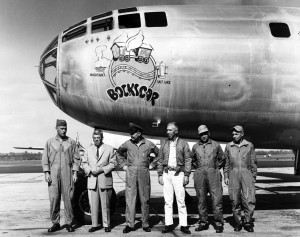
Bockscar, shown when it was delivered to the USAF Museum in 1961, with a group of its original crew. The nose art was added after the Nagasaki mission.
One of the museum’s more dramatic exhibits is the Bockscar, “the aircraft that ended WWII.” Named after its pilot, Frederick C. Bock, this Boeing B-29 bomber dropped the “Fat Man” atomic bomb on Nagasaki, Japan, which led to Japan’s surrender. Supposedly, people have seen the ghost of a young Japanese boy near the plane at night.
The Lady Be Good was a B-24D that disappeared after departing for a bombing mission over Italy on April 4, 1943. The other 24 bombers sent to Naples that day returned safely. But the Lady Be Good wasn’t found until sixteen years later, after a group of British archaeologists spotted wreckage while flying over the Libyan desert. After an intensive search of the area, remains of eight crew members were recovered, one of whom had trekked over 100 miles from the wreckage. The ninth crew member was never found. The aircraft was recovered in pieces, many of its instruments and equipment still in usable condition. Some of these parts were installed in other aircraft. According to the Lady Be Good fact sheet, a C-54 with autosyn transmitters from the Lady experienced propeller trouble; it managed to land safely only by ditching cargo. A C-47 with a radio receiver from the Lady had to be abandoned in the Mediterranean. An Army “Otter” plane got an armrest from the Lady Be Good, then crashed in the Gulf of Sidra. None of the ten men aboard were ever found. Some parts were, however – including the armrest. Now housed in the museum, the parts inexplicably rearrange themselves.
Another WWII-era B24D, the Strawberry Bitch is one of the museum’s more popular attractions. With a range of over 2,800 miles laden with 5,000 lbs. bomb load, the B24 was well-suited for longer range missions like the raid on the Ploesti oil fields in Rumania, which were estimated to supply 60 percent of Germany’s crude oil. Visitors and museum staff have reported hearing rattles and clanks from the undercage where the gunner sat, and some even claim to have seen a shadowy figure inside. Others say they’ve seen strange lights inside the aircraft. Whatever its/their nature, the spirit(s) haunting the Strawberry Bitch are the only ones said to be violent: a former janitor from the museum claims one slapped him in the face once. Who knows, maybe he made a comment about the plane’s pinup girl nose art. 😀

Prisoners of War exhibit at the National Museum of the United States Air Force
There’s one exhibit at the museum that isn’t an aircraft, but evokes a sense of dread and unease in more people than any other: the POW exhibit. With my skeptical nature, I’d be more inclined to believe this is simply due to knowing the horrible experiences suffered by our prisoners of war, rather than any paranormal activity. Still, it makes one wonder!
I have to admit, I didn’t see or hear any evidence of ghostly activity when I visited the museum. If you’ve been there, did you? Do you know of any haunted museums in your home town?
More at the My Town Monday blog
